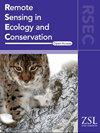Alpine greening deciphered by forest stand and structure dynamics in advancing treelines of the southwestern European Alps
IF 4.3
2区 环境科学与生态学
Q1 ECOLOGY
引用次数: 0
Abstract
Multidecadal time series of satellite observations, such as those from Landsat, offer the possibility to study trends in vegetation greenness at unprecedented spatial and temporal scales. Alpine ecosystems have exhibited large increases in vegetation greenness as seen from space; nevertheless, the ecological processes underlying alpine greening have rarely been investigated. Here, we used a unique dataset of forest stand and structure characteristics derived from manually orthorectified high‐resolution diachronic images (1983 and 2018), dendrochronology and LiDAR analysis to decipher the ecological processes underlying alpine greening in the southwestern French Alps, formerly identified as a hotspot of greening at the scale of the European Alps by previous studies. We found that most of the alpine greening in this area can be attributed to forest dynamics, including forest ingrowth and treeline upward shift. Furthermore, we showed that the magnitude of the greening was highest in pixels/areas where trees were first established at the beginning of the Landsat time series in the mid‐80s corresponding to a specific forest successional stage. In these pixels, we observe that trees from the first wave of establishment have grown between 1984 and 2023, while over the same period, younger trees established in forest gaps, leading to increases in both vertical and horizontal vegetation cover. This study provides an in‐depth description of the causal relationship between forest dynamics and greening, providing a unique example of how ecological processes translate into radiometric signals, while also paving the way for the study of large‐scale treeline dynamics using satellite remote sensing.通过欧洲西南部阿尔卑斯山脉林分和结构动态解密阿尔卑斯山绿化问题
卫星观测的多年代际时间序列,例如来自Landsat的观测,提供了在前所未有的空间和时间尺度上研究植被绿度趋势的可能性。从空间上看,高山生态系统的植被绿化率大幅增加;然而,高山绿化背后的生态过程很少被研究。在这里,我们使用了一个独特的森林林分和结构特征数据集,这些数据来自1983年和2018年的人工正校正高分辨率历时图像,树木年代学和激光雷达分析,以破译法国阿尔卑斯山西南部高山绿化的生态过程,该地区以前被先前的研究确定为欧洲阿尔卑斯山规模的绿化热点。研究发现,该地区高寒地区的绿化主要是由森林生长和林木线向上移动引起的。此外,我们还发现,在20世纪80年代中期Landsat时间序列开始时首次建立树木的像素/区域,绿化幅度最高,对应于特定的森林演替阶段。在这些像元中,我们观察到1984年至2023年间第一波树木的生长,而在同一时期,林隙中生长了更年轻的树木,导致垂直和水平植被覆盖增加。该研究深入描述了森林动态与绿化之间的因果关系,提供了生态过程如何转化为辐射信号的独特例子,同时也为利用卫星遥感研究大尺度树线动态铺平了道路。
本文章由计算机程序翻译,如有差异,请以英文原文为准。
求助全文
约1分钟内获得全文
求助全文
来源期刊

Remote Sensing in Ecology and Conservation
Earth and Planetary Sciences-Computers in Earth Sciences
CiteScore
9.80
自引率
5.50%
发文量
69
审稿时长
18 weeks
期刊介绍:
emote Sensing in Ecology and Conservation provides a forum for rapid, peer-reviewed publication of novel, multidisciplinary research at the interface between remote sensing science and ecology and conservation. The journal prioritizes findings that advance the scientific basis of ecology and conservation, promoting the development of remote-sensing based methods relevant to the management of land use and biological systems at all levels, from populations and species to ecosystems and biomes. The journal defines remote sensing in its broadest sense, including data acquisition by hand-held and fixed ground-based sensors, such as camera traps and acoustic recorders, and sensors on airplanes and satellites. The intended journal’s audience includes ecologists, conservation scientists, policy makers, managers of terrestrial and aquatic systems, remote sensing scientists, and students.
Remote Sensing in Ecology and Conservation is a fully open access journal from Wiley and the Zoological Society of London. Remote sensing has enormous potential as to provide information on the state of, and pressures on, biological diversity and ecosystem services, at multiple spatial and temporal scales. This new publication provides a forum for multidisciplinary research in remote sensing science, ecological research and conservation science.
 求助内容:
求助内容: 应助结果提醒方式:
应助结果提醒方式:


